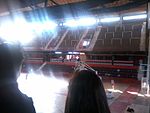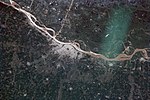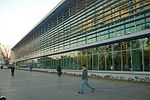Parque de la Independencia

The Parque de la Independencia (Independence Park) is a large public park in Rosario, province of Santa Fe, Argentina. It is located near the geographical center of the city, its limits defined by Moreno Street and three important avenues: Pellegrini Avenue, Ovidio Lagos Avenue, and 27 de Febrero Boulevard. It has a surface area of 1.26 km2 (0.49 sq mi). It includes a number of attractions: The Rosedal (Rose Garden), finished in 1915, with several species of roses, as well as sculptures and fountains. The French Garden, built in 1942, with many flower arrangements and a large marble fountain. The Calendar, where every evening since 1946 gardeners re-arrange the flowers to show the date written on the ground. An area reserved for fairs, initially intended for agricultural expositions, then also industry and commerce. The former Rosario Jockey Club's horsetrack. The Museum of the City, opened in 1902, initially the School of Gardener Apprentices. The Jorge Newbery Municipal Stadium, started in 1925, the first state-funded sports venue for public use in the country. It hosted the 2005 South American Junior Championships in Athletics. The Patinódromo Municipal "Roberto Tagliabué" (Municipal Skating Rink), opened for the 1982 Southern Cross Games and host of the 2014 Inline speed skating World Championship. The Juan B. Castagnino Fine Arts Museum, opened in 1937. The Dr. Julio Marc Provincial Historical Museum, opened in 1939. The Children's Garden, an area of 35,000 m2 (380,000 sq ft) with amusement and educational facilities.The park also hosts three sports clubs: Club Gimnasia y Esgrima, Club Atlético Newell's Old Boys (one of the main football teams in the city), Club Atlético Provincial.
Excerpt from the Wikipedia article Parque de la Independencia (License: CC BY-SA 3.0, Authors, Images).Parque de la Independencia
Avenida Dante Alighieri, Rosario Parque (Distrito Centro)
Geographical coordinates (GPS) Address Nearby Places Show on map
Geographical coordinates (GPS)
| Latitude | Longitude |
|---|---|
| N -32.958838888889 ° | E -60.659894444444 ° |
Address
Hipódromo Independencia (Hipódromo Rosario)
Avenida Dante Alighieri 2401
S2000 Rosario, Parque (Distrito Centro)
Santa Fe, Argentina
Open on Google Maps










